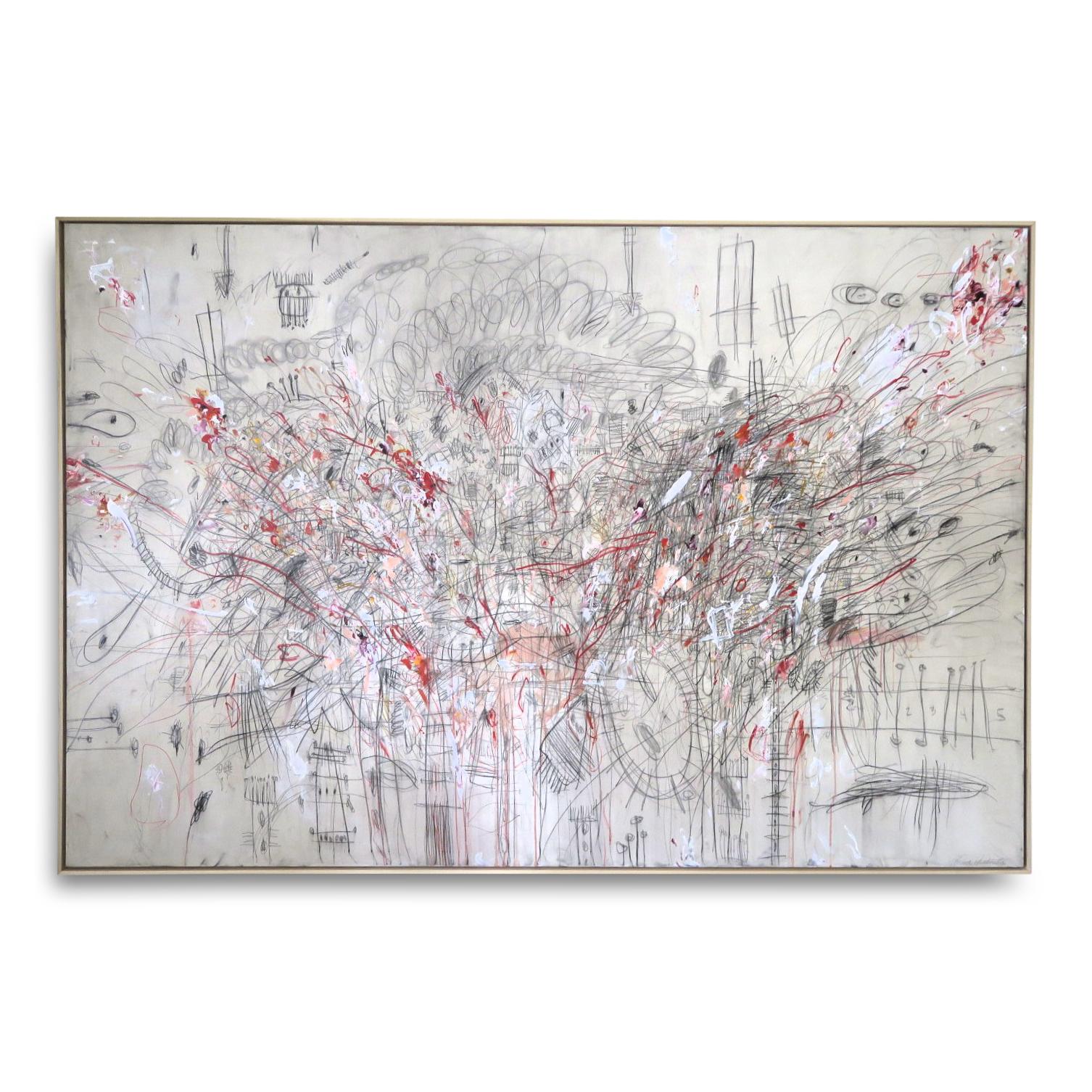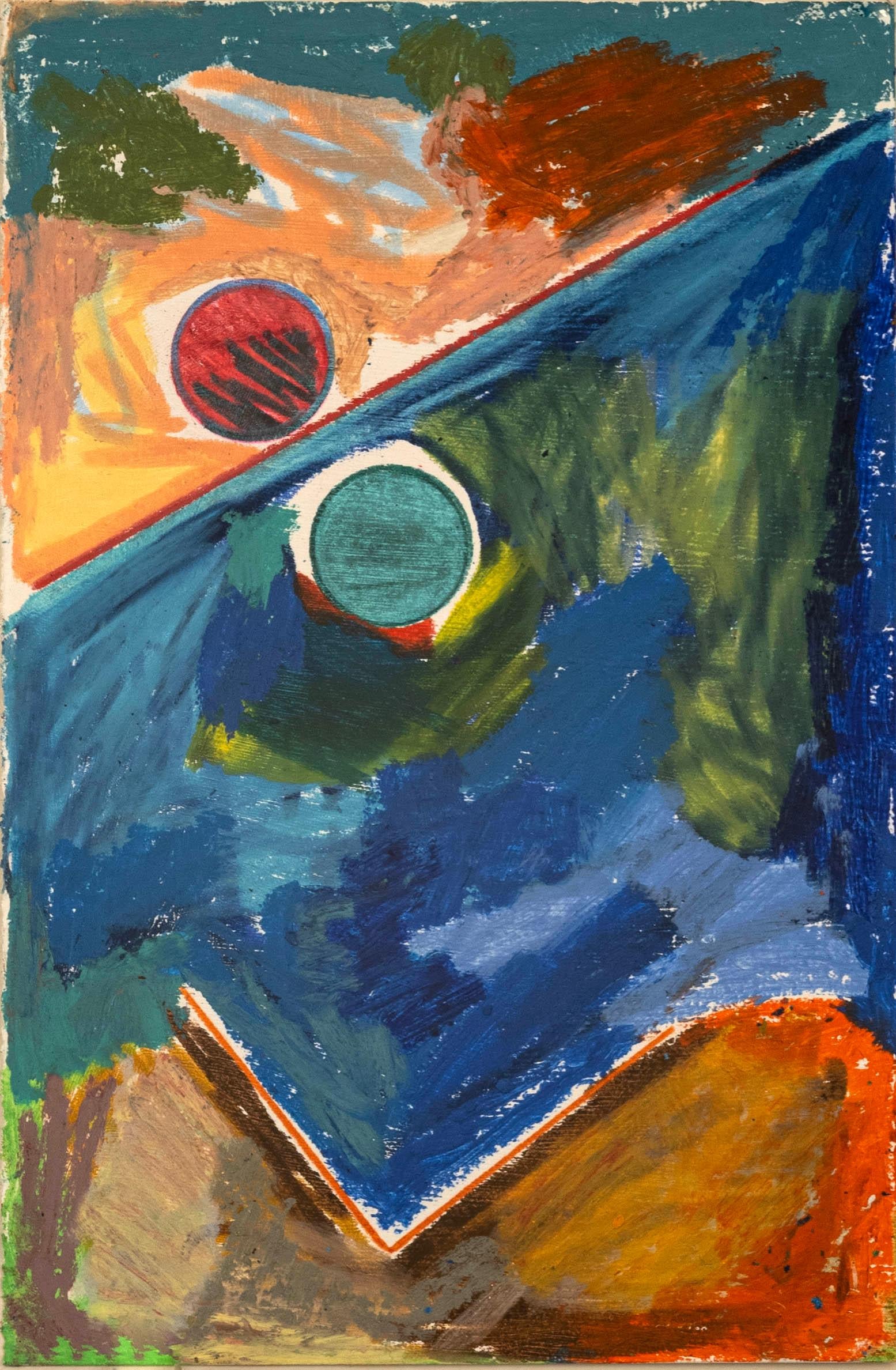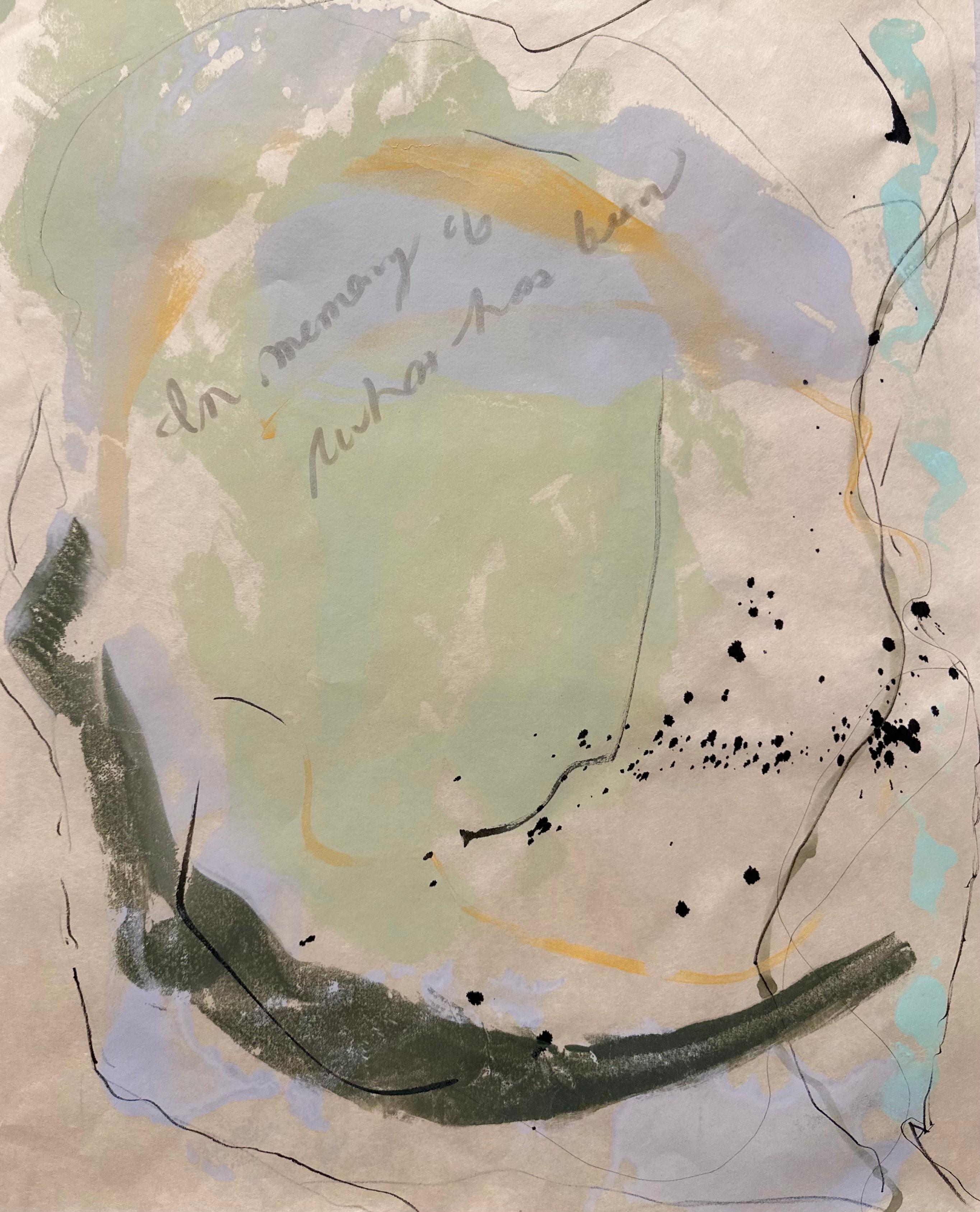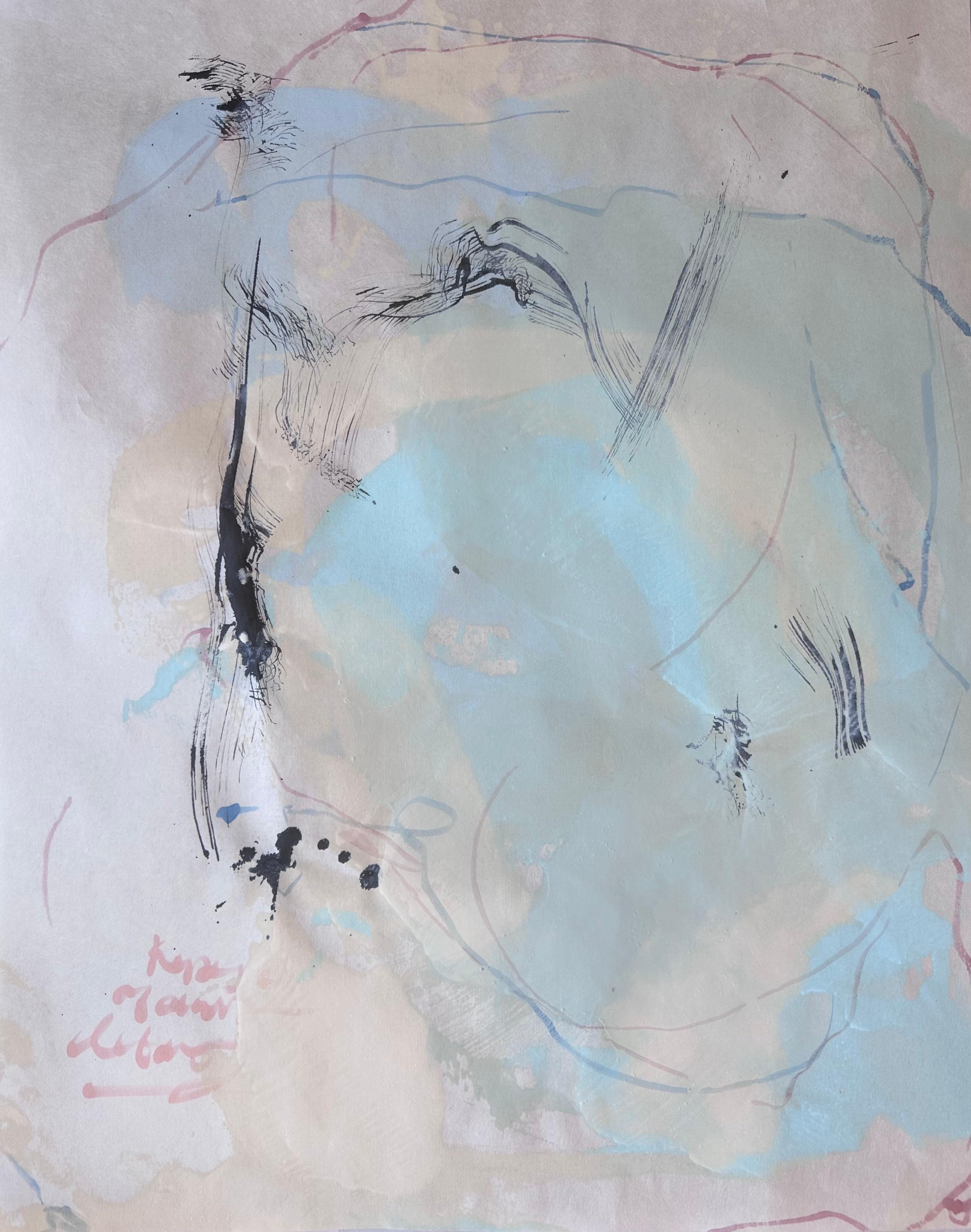Items Similar to “Three Children”
Want more images or videos?
Request additional images or videos from the seller
1 of 8
Molla Archer Moss“Three Children”Circa 1958
Circa 1958
About the Item
Original, rare work by the American female artist Molla Archer Moss. A mixed media work of oil on paper of three young children with the addition of wax sticks as the secondary medium. Signed “Molla” lower left. Condition is fair to good. Circa 1958. The artwork is under glass and in its original frame. 0verall framed measurements are 29.25 by 25 inches. Provenance: Roko Gallery and Frames, 925 Madison Avenue, New York (stamped verso).
Molla Archer Moss was born in 1916
Molla was a friend and contemporary to Jasper Johns. Molla’s work would often share a synergy to the constructed use of elements and materials upon which Johns is known.
Moss had several New York Exhibitions at the Marian Willard Gallery, East Hampton Gallery and the Rose Fried Gallery during the 1960s.
Moss is held within the collections of the Smithsonian, The Johnson Museum of Art New York as well as further records of her practice and life being held at the Guggenheim Museum.
- Creator:Molla Archer Moss (1916, American)
- Creation Year:Circa 1958
- Dimensions:Height: 16.5 in (41.91 cm)Width: 13.5 in (34.29 cm)Depth: 1 in (2.54 cm)
- Medium:
- Movement & Style:
- Period:
- Condition:Visible wrinkling of the paper surface.
- Gallery Location:Southampton, NY
- Reference Number:1stDibs: LU1419832802
About the Seller
5.0
Platinum Seller
These expertly vetted sellers are 1stDibs' most experienced sellers and are rated highest by our customers.
Established in 1977
1stDibs seller since 2013
469 sales on 1stDibs
Typical response time: 1 hour
- ShippingRetrieving quote...Ships From: Southampton, NY
- Return PolicyA return for this item may be initiated within 7 days of delivery.
More From This SellerView All
- “Mountains and …”By Nahum TschacbasovLocated in Southampton, NYOutstanding and vibrant figurative oil on canvas painting by the well known American artist, Nahum Tschacbasov. Signed lower right and dated 1945. Partial Perl’s Gallery, New York label verso with partial title on same label verso. Title might be “Mountains and Horses” Condition is very good. The painting is housed in it”s original House...Category
1940s Abstract Expressionist Figurative Paintings
MaterialsCanvas, Oil
- “Untitled”By John LittleLocated in Southampton, NYOriginal oil on canvas painting by the well known abstract expressionist artist, John Little. Signed lower right. Signed and dated 1965 on top stretcher bar verso. Betty Parsons Ga...Category
1960s Abstract Expressionist Abstract Paintings
MaterialsCanvas, Oil
- “Lightride”By Syd SolomonLocated in Southampton, NYHere for your consideration is a great example of the artwork of the well known American artist, Syd Solomon. Signed top left. Titled and dated verso 1978. The painting is oil and acrylic paint on mounted synthetic canvas. Condition is excellent. Overall framed measurements are 44.75 by 24.5 inches. Provenance: A Sarasota, Florida collector. SYD SOLOMON BIOGRAPHY American 1917-2004 Written by Dr. Lisa Peters/Berry Campbell Gallery “Here, in simple English, is what Syd Solomon does: He meditates. He connects his hand and paintbrush to the deeper, quieter, more mysterious parts of his mind- and he paints pictures of what he sees and feels down there.” --Kurt Vonnegut Jr. from Palm Sunday, 1981 Syd Solomon was born near Uniontown, Pennsylvania, in 1917. He began painting in high school in Wilkes-Barre, where he was also a star football player. After high school, he worked in advertising and took classes at the Art Institute of Chicago. Before the attack on Pearl Harbor, he joined the war effort and was assigned to the First Camouflage Battalion, the 924th Engineer Aviation Regiment of the US Army. He used his artistic skills to create camouflage instruction manuals utilized throughout the Army. He married Ann Francine Cohen in late 1941. Soon thereafter, in early 1942, the couple moved to Fort Ord in California where he was sent to camouflage the coast to protect it from possible aerial bombings. Sent overseas in 1943, Solomon did aerial reconnaissance over Holland. Solomon was sent to Normandy early in the invasion where his camouflage designs provided protective concealment for the transport of supplies for men who had broken through the enemy line. Solomon was considered one of the best camoufleurs in the Army, receiving among other commendations, five bronze stars. Solomon often remarked that his camouflage experience during World War II influenced his ideas about abstract art. At the end of the War, he attended the École des Beaux-Arts in Paris. Because Solomon suffered frostbite during the Battle of the Bulge, he could not live in cold climates, so he and Annie chose to settle in Sarasota, Florida, after the War. Sarasota was home to the John and Mable Ringling Museum of Art, and soon Solomon became friends with Arthur Everett “Chick” Austin, Jr., the museum’s first Director. In the late 1940s, Solomon experimented with new synthetic media, the precursors to acrylic paints provided to him by chemist Guy Pascal, who was developing them. Victor D’Amico, the first Director of Education for the Museum of Modern Art, recognized Solomon as the first artist to use acrylic paint. His early experimentation with this medium as well as other media put him at the forefront of technical innovations in his generation. He was also one of the first artists to use aerosol sprays and combined them with resists, an innovation influenced by his camouflage experience. Solomon’s work began to be acknowledged nationally in 1952. He was included in American Watercolors, Drawings and Prints at the Metropolitan Museum of Art, New York. From 1952–1962, Solomon’s work was discovered by the cognoscenti of the art world, including the Museum of Modern Art Curators, Dorothy C. Miller and Peter Selz, and the Whitney Museum of American Art’s Director, John I. H. Baur. He had his first solo show in New York at the Associated American Artists Gallery in 1955 with “Chick” Austin, Jr. writing the essay for the exhibition. In the summer of 1955, the Solomons visited East Hampton, New York, for the first time at the invitation of fellow artist David Budd...Category
1970s Abstract Expressionist Abstract Paintings
MaterialsCanvas, Oil, Acrylic, Board
- “Gulfside”By Syd SolomonLocated in Southampton, NYOriginal, oil paint and acrylic paint on canvas by the well known American artist, Syd Solomon. Signed bottom middle by the artist. Titled and dated verso 1983. Condition is excellent. Original gallery floating frame. Overall framed measurements are 38 by 42 inches. Provenance: A Sarasota, Florida collector. SYD SOLOMON BIOGRAPHY Written by Dr. Lisa Peters/Berry Campbell Gallery “Here, in simple English, is what Syd Solomon does: He meditates. He connects his hand and paintbrush to the deeper, quieter, more mysterious parts of his mind- and he paints pictures of what he sees and feels down there.” --Kurt Vonnegut Jr. from Palm Sunday, 1981 Syd Solomon was born near Uniontown, Pennsylvania, in 1917. He began painting in high school in Wilkes-Barre, where he was also a star football player. After high school, he worked in advertising and took classes at the Art Institute of Chicago. Before the attack on Pearl Harbor, he joined the war effort and was assigned to the First Camouflage Battalion, the 924th Engineer Aviation Regiment of the US Army. He used his artistic skills to create camouflage instruction manuals utilized throughout the Army. He married Ann Francine Cohen in late 1941. Soon thereafter, in early 1942, the couple moved to Fort Ord in California where he was sent to camouflage the coast to protect it from possible aerial bombings. Sent overseas in 1943, Solomon did aerial reconnaissance over Holland. Solomon was sent to Normandy early in the invasion where his camouflage designs provided protective concealment for the transport of supplies for men who had broken through the enemy line. Solomon was considered one of the best camoufleurs in the Army, receiving among other commendations, five bronze stars. Solomon often remarked that his camouflage experience during World War II influenced his ideas about abstract art. At the end of the War, he attended the École des Beaux-Arts in Paris. Because Solomon suffered frostbite during the Battle of the Bulge, he could not live in cold climates, so he and Annie chose to settle in Sarasota, Florida, after the War. Sarasota was home to the John and Mable Ringling Museum of Art, and soon Solomon became friends with Arthur Everett “Chick” Austin, Jr., the museum’s first Director. In the late 1940s, Solomon experimented with new synthetic media, the precursors to acrylic paints provided to him by chemist Guy Pascal, who was developing them. Victor D’Amico, the first Director of Education for the Museum of Modern Art, recognized Solomon as the first artist to use acrylic paint. His early experimentation with this medium as well as other media put him at the forefront of technical innovations in his generation. He was also one of the first artists to use aerosol sprays and combined them with resists, an innovation influenced by his camouflage experience. Solomon’s work began to be acknowledged nationally in 1952. He was included in American Watercolors, Drawings and Prints at the Metropolitan Museum of Art, New York. From 1952–1962, Solomon’s work was discovered by the cognoscenti of the art world, including the Museum of Modern Art Curators, Dorothy C. Miller and Peter Selz, and the Whitney Museum of American Art’s Director, John I. H. Baur. He had his first solo show in New York at the Associated American Artists Gallery in 1955 with “Chick” Austin, Jr. writing the essay for the exhibition. In the summer of 1955, the Solomons visited East Hampton, New York, for the first time at the invitation of fellow artist David Budd...Category
1980s Abstract Expressionist Abstract Paintings
MaterialsCanvas, Oil, Acrylic
- “Turning”By Syd SolomonLocated in Southampton, NYOriginal oil paint and acrylic paint on canvas by the well known American artist, Syd Solomon. Signed bottom middle. Titled and dated verso, 1977/1978. The location for the painting is Midnight Pass near where the artist once lived in Sarasota, Florida. Condition is excellent. The painting is housed in its original gallery frame with silver edge. Overall framed measurements are 51 by 38 inches. Provenance: A Sarasota, Florida collector. American, 1917-2004 SYD SOLOMON BIOGRAPHY: Written by Dr. Lisa Peters/Berry Campbell Gallery “Here, in simple English, is what Syd Solomon does: He meditates. He connects his hand and paintbrush to the deeper, quieter, more mysterious parts of his mind- and he paints pictures of what he sees and feels down there.” --Kurt Vonnegut Jr. from Palm Sunday, 1981 Syd Solomon was born near Uniontown, Pennsylvania, in 1917. He began painting in high school in Wilkes-Barre, where he was also a star football player. After high school, he worked in advertising and took classes at the Art Institute of Chicago. Before the attack on Pearl Harbor, he joined the war effort and was assigned to the First Camouflage Battalion, the 924th Engineer Aviation Regiment of the US Army. He used his artistic skills to create camouflage instruction manuals utilized throughout the Army. He married Ann Francine Cohen in late 1941. Soon thereafter, in early 1942, the couple moved to Fort Ord in California where he was sent to camouflage the coast to protect it from possible aerial bombings. Sent overseas in 1943, Solomon did aerial reconnaissance over Holland. Solomon was sent to Normandy early in the invasion where his camouflage designs provided protective concealment for the transport of supplies for men who had broken through the enemy line. Solomon was considered one of the best camoufleurs in the Army, receiving among other commendations, five bronze stars. Solomon often remarked that his camouflage experience during World War II influenced his ideas about abstract art. At the end of the War, he attended the École des Beaux-Arts in Paris. Because Solomon suffered frostbite during the Battle of the Bulge, he could not live in cold climates, so he and Annie chose to settle in Sarasota, Florida, after the War. Sarasota was home to the John and Mable Ringling Museum of Art, and soon Solomon became friends with Arthur Everett “Chick” Austin, Jr., the museum’s first Director. In the late 1940s, Solomon experimented with new synthetic media, the precursors to acrylic paints provided to him by chemist Guy Pascal, who was developing them. Victor D’Amico, the first Director of Education for the Museum of Modern Art, recognized Solomon as the first artist to use acrylic paint. His early experimentation with this medium as well as other media put him at the forefront of technical innovations in his generation. He was also one of the first artists to use aerosol sprays and combined them with resists, an innovation influenced by his camouflage experience. Solomon’s work began to be acknowledged nationally in 1952. He was included in American Watercolors, Drawings and Prints at the Metropolitan Museum of Art, New York. From 1952–1962, Solomon’s work was discovered by the cognoscenti of the art world, including the Museum of Modern Art Curators, Dorothy C. Miller and Peter Selz, and the Whitney Museum of American Art’s Director, John I. H. Baur. He had his first solo show in New York at the Associated American Artists Gallery in 1955 with “Chick” Austin, Jr. writing the essay for the exhibition. In the summer of 1955, the Solomons visited East Hampton, New York, for the first time at the invitation of fellow artist David Budd...Category
1970s Abstract Expressionist Abstract Paintings
MaterialsCanvas, Oil, Acrylic
- “Mother and Child”By Nahum TschacbasovLocated in Southampton, NYOriginal oil on canvas painting by the well known Russian/American artist, Nahum Tschacbasov. Signed middle right and dated 1943. Condition is very good. Unlined canvas. The painti...Category
1940s Abstract Expressionist Figurative Paintings
MaterialsCanvas, Oil
You May Also Like
- "Gioia" Large Scale Acrylics, Oil Pastels and Pencils Abstract Painting 72"x108"By Karina GentinettaLocated in New York, NY"Gioia" ("Joy" in Italian) 2023, 72" x 108" large scale acrylics, house paint, oil pastels, wax crayons, and pencils abstract work on canvas by Argentine born artist Karina Gentinett...Category
21st Century and Contemporary Abstract Expressionist Mixed Media
MaterialsOil Pastel, Wax Crayon, House Paint, Acrylic, Carbon Pencil, Color Pencil
- SunsetLocated in New York, NYOil pastel, wax pastel, color pencil on paper.Category
2010s Abstract Expressionist Mixed Media
MaterialsOil Pastel, Wax Crayon, Color Pencil
- UntitledBy Michael GoldbergLocated in Austin, TXOil, pastel, and paper collage on canvas. Signed and dated verso. 52.75 x 47.75 in. 54 x 49 in. (framed) Gilded floater frame. Provenance Compass Rose, Chicago Born Sylvan Irwin Goldberg in 1924 and raised in the Bronx, Michael Goldberg was an important figure in American Abstract Expressionism, who began taking art classes at the Art Students League in 1938. A gifted student, Goldberg finished high school at the age of 14 and enrolled in City College. He soon found New York’s jazz scene to be a more compelling environment, and he began skipping classes in favor of the Harlem jazz clubs near campus. Goldberg’s love of jazz would become a lifelong passion and a key component to his approach to composition in his paintings. From 1940 to 1942, like many of the leading artists of the New York School, Goldberg studied with Hans Hofmann. In 1943, he put his pursuit of painting on hold and enlisted in the U.S. Army. Serving in North Africa, Burma, and India, Goldberg received a Purple Heart and a Bronze Star before being discharged in 1946. After his service, he traveled and worked in Venezuela before returning to the United States, settling back in New York and resuming studies with Hofmann and at the Art Students League. Living downtown and frequenting the Cedar Bar, Goldberg befriended many of the artists of the New York School. In 1951, his work was included in the groundbreaking Ninth Street Show, co-organized by Leo Castelli, Conrad Marca-Relli, and the Eighth Street Club, and featuring the work of - among others - Hofmann, Jackson Pollock, Willem de Kooning, and Franz Kline. In 1953, the Tibor de Nagy...Category
1980s Abstract Expressionist Abstract Paintings
MaterialsCanvas, Pastel, Mixed Media, Oil, Handmade Paper
- And His Open Arms EmbracedLocated in Clayton, MOIn And His Open Arms Embraced color, line, shape, and texture collide with handwritten romantic fragments of prose on Kozuke ivory paper. This one-of-a-kind, unmounted encaustic mono...Category
2010s Abstract Abstract Paintings
MaterialsWax Crayon, India Ink, Encaustic, Archival Paper, Rice Paper, Pen, Color...
- In Memory Of What Has BeenLocated in Clayton, MOIn Memory Of What Has Been color, line, shape, and texture collide with handwritten romantic fragments of prose on Kozuke ivory paper. This one-of-a-kind, unmounted encaustic monotyp...Category
2010s Abstract Abstract Paintings
MaterialsWax Crayon, India Ink, Encaustic, Archival Paper, Rice Paper, Pen, Color...
- But Now A Dreamlike MemoryLocated in Clayton, MOIn But Now A Dreamlike Memory color, line, shape, and texture collide with handwritten romantic fragments of prose on Kozuke ivory paper. This one-of-a-kind, unmounted encaustic mono...Category
2010s Abstract Abstract Paintings
MaterialsWax Crayon, India Ink, Encaustic, Archival Paper, Rice Paper, Pen, Color...





